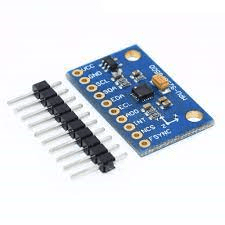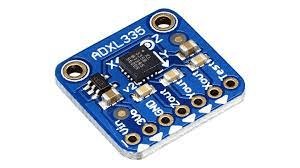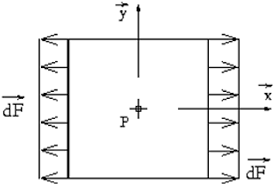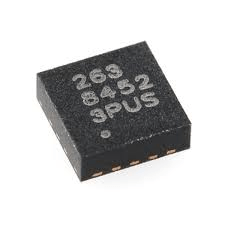The accelerometer is known for measuring the rate of change of speed. So, measuring acceleration has been always one of the challenging aspects in the area of electronics and instrumentation. With the advent of microelectronics and microcontrollers, measuring the rate of change of speed has found new dimensions, blended with old fundamental principles.
An accelerometer is widely used to measure the rate of change of speed in three-dimensional space. These devices essentially work on fundamental laws of physics, have brought revolutionary changes in the field of measuring and navigation.
What is an Accelerometer?
Accelerometers are devices, which are used to measure the proper acceleration of a particular body. Acceleration is fundamentally defined as a change of speed over a given time. In other words, acceleration defines the rate of change of speed with respect to time. For a given body, if we can measure the distance and time taken to cover, then the speed can be obtained.

Accelerometer
However, to measure acceleration, the force comes into the picture. Accelerometers have found wide applications in recent times. Even accelerometers are found in mobile phones also by using micro electronic and mechanical systems.
How does the Accelerometer Work?
Accelerometers are used to measure the rate of change of speed, or acceleration. For this measurement, force applied is considered.
As per Newton’s first law, “An object at rest or an object in motion will remain that way unless acted upon by a force”. It implies that, for an object to change its position, with respect to time, a force needs to be applied. Otherwise, it will remain in its initial position, for an infinite amount of time. This is due to the inertia of the body.
The same happens when the body is in motion. If a body is in motion, then if due to some external factor, it is brought to rest suddenly, then it tends to be in motion for some time. As per Newton’s second law of motion, force is defined as the product of mass and acceleration.

Newton’s Law of Motion
It can be expressed as F = (m.a). Where m is the mass of the body and a is the acceleration. Mass is defined as the amount of matter in a body. Now in order to measure, acceleration, which is required for the accelerometer, the above equation can be modified as a = (F/m). This means that acceleration can be obtained by dividing the force acted upon by mass.
Units of Measurement for Acceleration
For the calculation of acceleration, we need force. Now, what type of force is to be considered for the measurement of acceleration. One constant force, which is used to measure acceleration, is gravity. Gravity is the force that is acted due to the gravitational forces of the earth.
Based upon the mass of the body, and known gravitational force, we can measure the acceleration of the body. Now in order to express the acceleration, we have different units followed. The acceleration can be expressed as a meter per second square, ( or Gal (and standard gravity (g). The standard gravity is the force created due to the gravitational force of the earth. It is defined as “Standard gravity, is the nominal gravitational acceleration of an object in a vacuum near the surface of the earth”.
It is denoted by g0. This force is essentially defined in a vacuum. It essentially means that, if all the external forces like friction due to wind, etc. are removed, then the acceleration of a particular body is defined by the gravitational force upon the mass of the body. The value of one unit of gravitational force is defined as
Accelerometer Specifications
While looking for accelerometers, one should look for ‘g’ rating. It represents the full dynamic range, the device is capable of. It is usually represented as plus/minus 2g or 4g. For example, the accelerometer chip ADXL335 manufactured by Analog devices has the specification of 3 axes plus/minus 3g. This means it has a full dynamic range of 3 times the gravitational forces. Similarly, life augmented LSM303AGR has the range of plus/minus 2g to 16g.

Accelerometer ADXL335
Similarly, we have measurement range and sensitivity specifications for each accelerometer. The device with 2g specifications has a low amplitude range, but whereas very high sensitivity. But whereas the accelerometer with high g, like 8g has high amplitude but low sensitivity. The device with good sensitivity can measure sudden changes in the values. So in the larger range, sensitivity is less and in the lower range, sensitivity is high.
Accelerometer Types
Based on the operating principle, the accelerometers are classified as
- Piezoelectric Based
- MEMS-Based
Piezoelectric Accelerometer
The accelerometers of this type, work based on the piezoelectric effect. The piezoelectric effects are based upon the crystalline structure of the device. In this effect, a crystal layer is placed between two electrodes. The crystal is defined as a structure made up of positive and negative ions. The configuration of these ions depends on the atomic structure of the crystal used.

Piezoelectric Effect
The two electrodes above and below, act as positive and negative electrodes. When force is applied, the structure distorts. Due to the distortion caused by the force, the electrons present in the crystalline structure, shift around, causing electric currents to flow. The flow of electrons creates, electric charge.
And the amount of electric charge generated is proportional to the force applied. Hence the force applied can be evaluated, by calculating the amount of electric charge generated. Now the acceleration, which fundamentally requires force to be evaluated, can be measured by calculating the force generated in the layers.
MEMS Accelerometer
MEMS stands for micro-electro-mechanical systems. Hence the accelerometers, designed based on microelectromechanical systems can be effectively used since most of the electronic applications have MEM’s chips installed. The MEMS devices are microscopic electronics circuits, printed directly on circuit boards. Due to low power and micro applications, these devices have found huge applications in different fields.

MEMS Accelerometers
Such systems have two structures, one is fixed with anchor-based, and the other one is variable based on springs. Also called anchor and proof mass. The force calculated here depends on the capacitance formed between two structures. The capacitance is inversely proportional and can be calculated based on the distance between two plates.
The anchor mass and proof mass form a plate each. And based on the distance between the two, the capacitance can be evaluated. The distance between the floating mass i.e. proof mass changes due to the force applied. It results in the increase or decrease of the capacitance. This can be used to calculate acceleration, based on the mass of the body. The force exerted can be extended to three-dimensional space.
The biggest advantage of MEMs accelerometers is the acceleration in all the 3-dimensional space can be printed on the electronic circuit boards, and the meters can measure acceleration in all three dimensions. This is not possible in a piezoelectric-based accelerometer.
Please refer to this link to know more about the capacitive transducer
Difference Between Accelerometer and Gyroscope
The fundamental difference between accelerometer and gyroscope is, the accelerometers are used to measure linear acceleration, along with one or several axes. Linear in the sense, the displacement or rate of change of speed is linear or proportional with respect to time.
If we plot a graph between the rate of change of speed, and time, we would obtain a straight line, passing through the origin. But for gyroscopes, it is not the case. The gyroscope measures angular velocity. That is the displacement is evaluated in terms of degrees.
In this case, it is not linear acceleration, but angular displacement that comes into the picture. A gimbal is one popular application of gyroscope. The difference between the accelerometer and gyroscope can be enlisted as
- Accelerometer measures linear acceleration, gyroscope measures angular velocity
- The unit for the accelerometer is mv/g. The unit for the gyroscope is mv/deg/s.
- The accelerometer will not respond to rotational displacements. Which is possible in the case of gyroscopes.
- The sensor’s specifications for accelerometers and gyroscopes are different.
Please refer to this link to know more about Accelerometer MCQs.
Applications
The applications of accelerometers include the following.
Due to their efficacy, accelerometers have numerous applications. The usage of accelerometers is classified based on the quantity to be measured. For example, to measure vibration, accelerometers are used in cars, vibration sensors, process controls, controllers, mobile phones, etc. For all these applications, specific chips are built.
To measure the seismic activity, the accelerometers are used as earthquake sensors, building sensors, inclination, etc. Apart from all these, there is the specific application of accelerometers, which are used to measure gravity. They are called gravimeters.
The other applications of accelerometers, come as orientation control or motion control. They are widely used in video games and even the aviation industry. Then they are also used in hand portable devices for measuring navigation like smartwatches. One popular application of accelerometer has been found in virtual reality game devices. They can be easily worn, and have high precision specifically.
Some recent applications of accelerometers have been found in drones, which are very useful in navigation. This has found numerous applications in the defense industry. One common application of accelerometers can be found in mobile phones. Like for example, if you are watching a video on youtube, and if you rotate the phone, then accordingly the screen on the phone display goes into full-screen mode. This is one of the cool applications of accelerometers. The phone knows, when it is being tilted.
1). Which is an Example of an Accelerometer?
Ans. A simple mobile phone is an example of an accelerometer, as it detects the motion of the phone. The phone can sense the motions. For this, a simple MEMS-based accelerometer sensor can be placed inside the phone. Other examples are virtual reality devices, navigators, gravity meters, etc.
2). What is the Range of the Accelerometer?
Ans. Accelerometer range is defined based on the force variation. This range can vary up from 1g to 250g. Another important factor of the range is sensitivity and amplitude measurement, which are inversely proportional.
3). Can Accelerometers Measure Amplitude?
Ans. Yes, accelerometers can measure amplitude. Generally, to measure amplitude, accelerometers with low sensitivity are preferred. Since low sensitivity accelerometers can measure high amplitudes. And similarly, high sensitivity accelerometers can measure low amplitudes.
Please refer to this link to know more about Hall Effect MCQs.
Please refer to this link to know more about Synchroscope.
Hence, we have seen the working and applications of accelerometers. These devices have gained huge popularity, especially due to the advent of MEMS devices. A huge number of applications can be designed by using MEMS sensors and can be built with cost-efficiency.